Panasonic Lumix DC-G100/G110 review
Product photography by Dan Bracaglia
The G100 is a 20MP Micro Four Thirds mirrorless camera designed explicitly for vloggers and content creators. It features a 'tracking' audio system that works in conjunction with the camera's face detection system and a flip-out screen that, by default, engages several easy-to-use modes.
Above all, though, Panasonic has done its best to make the camera as small as possible. We'll find out more about the tradeoffs involved as we discuss the specifications in more detail.
Jump to:
What's new | How it compares | Body & handling | Image Quality | Autofocus | Video | Conclusion | Sample gallery | Specifications
The G100 is available in a variety of kits, including one that bundles it with a small tabletop tripod/selfie grip.
In the US, the camera is offered with the compact, stabilized 12-32mm F3.5-5.6 lens for $749 or with the 12-32mm and selfie grip for $799. Options with the larger, more flexible 12-60mm are available in other territories.
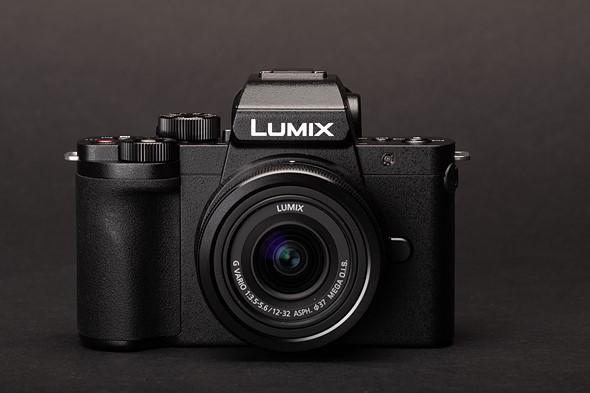
With Panasonic's explicit focus on vlogging, it should come as no surprise that the bulk of the G100's stand-out features relate either to video or serve an intent on the part of the company's designers to keep the camera small and light.
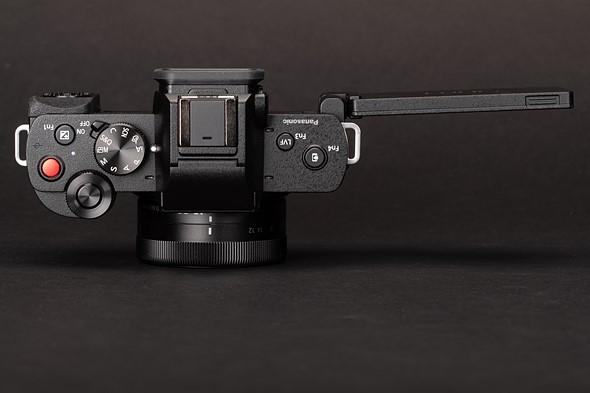
The most distinctive feature of the G100 is its directional audio modes. These offer a series of ways of using the camera's three built-in microphones, including technology licensed from Nokia's 'OZO' VR project.
The microphones have a front, rear or surround pickup pattern, but also include a 'tracking' mode that adjusts the mic response direction based on the camera's face detection system. The audio is adjusted to pick up audio from the direction of the recognized face, and to actively reduce the input from other directions, limiting background noise sources.
In the camera's default 'Auto' mode, the camera will use tracking mode if there's a face present and surround mode if there isn't.
The G100 doesn't include a physical image stabilization system, instead using an electronic IS (EIS) system in video mode that can work in sync with in-lens stabilization.
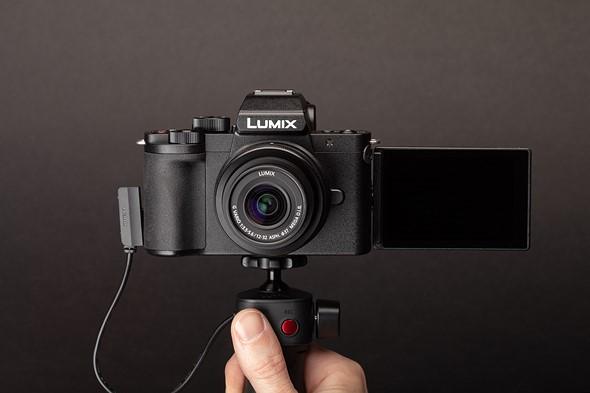
This means lens-only IS when shooting stills, but with the option of five-axis digital correction in 1080 mode and four-axis stabilization when capturing 4K.
Panasonic says the EIS system in the G100 uses the same sensors and algorithms as its physical systems, but selects the area of the sensor being used, rather than physically moving the sensor itself. This requires that the video gets cropped-in.
The camera switches to a simple 'Self Shot' mode when you turn the screen to face forward.

This engages face detection and tracking audio mode, as well as popping-out an onscreen touchscreen tab from which you can select a series of functions you might want access to, including options such as Skin Smoothing, Effect Filters and Background Control, which blurs the background.
By default the camera also applies a three-second self-timer to both stills and video shooting in Self Shot mode. Touch Shutter is engaged but there are also options such as firing the shutter when two faces are placed next to one another.
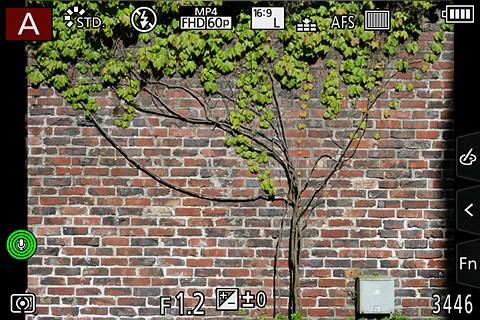
In the menus you can change whether AF is initiated before or after the 3-second countdown has happened, or you can turn off 'Self Shot' mode entirely.
To make it easy to tell when the camera is recording, a red frame appears around the screen when it's capturing footage.
The G100 offers a range of video modes including UHD 4K and Full HD, with fast and slow-mo options in the latter.
The slow/quick modes continue to provide autofocus, though do not capture audio.
The G100 inherits a number of features from Panasonic's higher-end video cameras, including the 8-bit variant of the V-Log L gamma curve, and the on-screen VU audio meters, to help with setting volume levels.
The G100 also gains the ability to show framing guides for a variety of aspect ratios. These include 1:1 and 9:16, so you can shoot content for YouTube, but make sure that the action all takes place in a region that can be best-cropped for Instagram.
The G100 can also shoot vertical video, including all necessary metadata within the files to ensure they're played back in that orientation.
The G100 uses an electronic first curtain shutter that limits its flash sync speed to 1/50th seconds. This limits the ability to use the camera's built-in flash as 'fill' to counteract shadows.
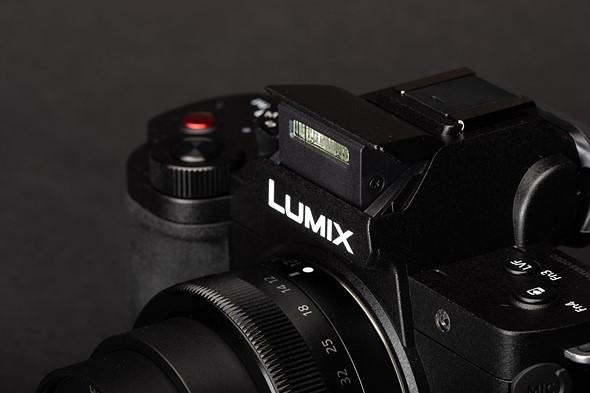
By default the G100 will auto-switch between electronic first curtain and full electronic shutter but we found the camera would only use the electronic shutter when it absolutely had to, with P and Auto modes often using very small apertures to avoid using the fully electronic shutter, resulting in soft images.
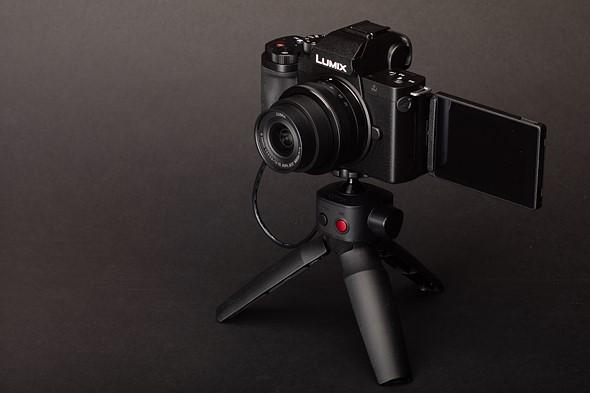
There's a selfie grip/tripod (DMW-SHGR1) designed to match the G100. It connects via the camera's USB port and includes shutter, REC and 'sleep' buttons, for arms-length operation of the camera. It also doubles as a tabletop tripod. It is usually less expensive when bought as a kit with the camera and feels pretty inexpensive.
Return to index
The obvious camera to compare the Panasonic against is the Sony ZV-1. They're two rather different attempts to make vlogging cameras from a mixture of existing components and interesting ideas (tracking audio in the case of the G100, vlogging-specific AF modes on the Sony).
We've also lined it up next to two Canon cameras that are popular with vloggers: the M50 Mark II, which has reliable Dual Pixel AF, and the compact PowerShot G7 X Mark III.
4K: 10 min1080/60: 20 min1080/30: 29:59
IS Off: 1.55xIS Std: 1.73xIS High: 2.22x
IS Off: 1.00xIS Std: 1.11xIS High: 1.43x
116 x 83 x 54 mm
The more sophisticated microphones of the Panasonic and Sony are highlights, but the video crops are the detail worth paying most attention to. Cropping video not has the potential to affect image quality but it also makes it hard to capture a wide-angle field of view.
Return to index
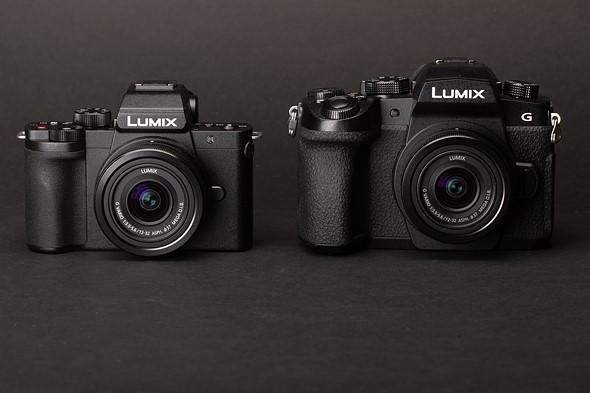
The G100 is an impressively small camera, seemingly owing as much to the GM lineup of cameras as any of Panasonic's current models. We're already covered the implications of this downsizing (the simplified shutter mechanism and electronic image stabilization system). In the hand, the camera feels dense and solidly built, without being excessively heavy.
The use of such a small body provides room for a prominent command dial on the front lip of the camera, surrounding the shutter button. However, there's no backward-facing dial as could be found on the GM5, and instead there's a rather fiddly dial around the four-way controller which acts as a secondary control point.
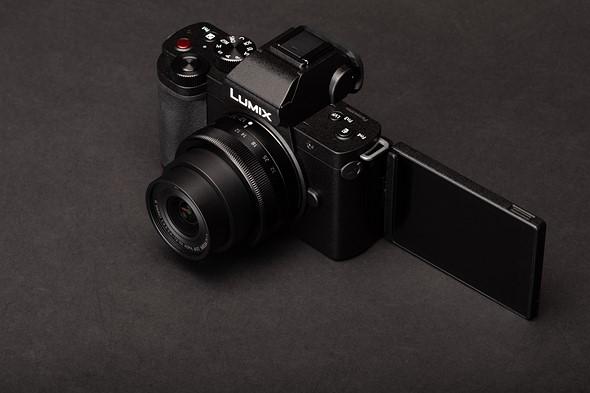
The G100 has a remarkably bright 1.84M-dot LCD that rotates nearly 180 degrees forward so you can see what you're recording when facing the camera.
The G100 also includes a built-in viewfinder for when you're not vlogging. It projects its three primary colors one after another but does so fast enough that there aren't too many distracting artefacts. Overall it's a good-sized finder that's useful when it's too bright to see the screen.
Other than the 'Self shot' mode, most of the G100's interface is pretty standard for a modern Panasonic camera.
The main menu is fairly straightforward, with options separated into fairly logical tabs. The most complex of these - the Custom Settings tab - is sub-divided into five sections to make it easier to find the setting you're looking for.
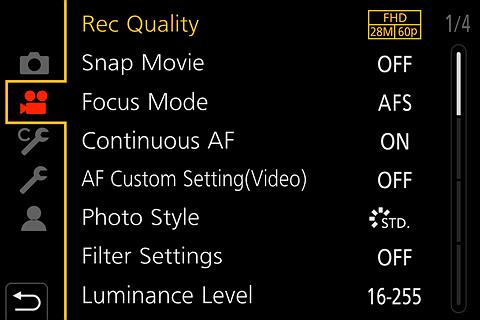
The main menu is fairly logically arranged. The tab at the top left varies, depending on which drive mode you've selected.
The bottom-most tab is a customizable 'My Menu' tab
There's a customizable 'My Menu' tab if there are menu settings you regularly find yourself needing to change.
You get a different version of the menu with a video, rather than camera tab at the top left, if you set the mode dial to Creative Movie mode. Similarly there's a different initial tab in the Slow&Quick mode.
There's also a Q.Menu that appears as an overlay on the live view while you're shooting.
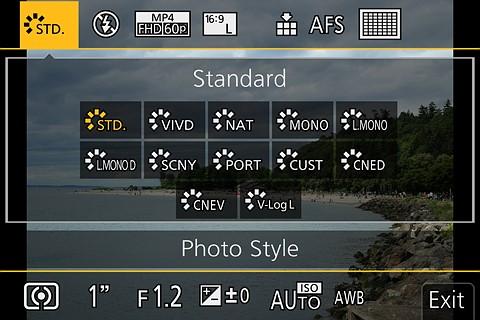
By default this arrays a series of settings along the top and bottom of the screen, but there's also a Custom option (Custom Settings > Operation > Q.Menu) that lets you select up to fifteen settings that appear in a more touchscreen-friendly display.
For the most part, the menus and button arrangement will be fairly familiar to anyone with experience of other Panasonic bodies. The menus are laid out logically enough that you can find options pretty quickly without having to memorize their location and, between the custom buttons the customizable Q.Menu and the My Menu tab, it's easy enough to give yourself access to the settings you find yourself regularly wanting to change.
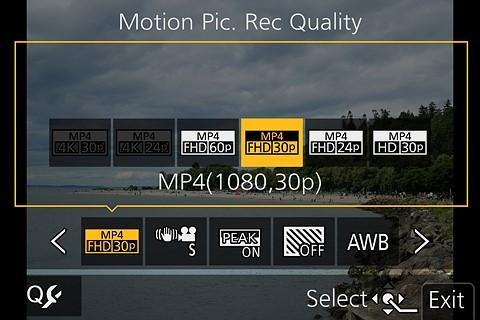
The irritations we had tended to relate more to the things you can't change. You can't re-define or disengage the functions assigned to the cardinal points of the four-way controller. Between this and the imprecise secondary dial and the easily pressed four-way controller, we managed to accidentally shoot a whole sequence of images in manual WB, rather than Auto.
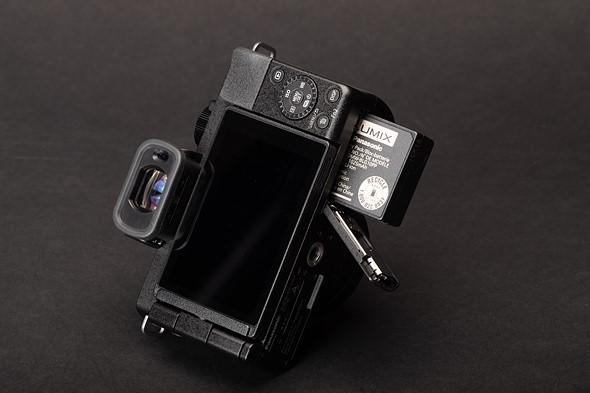
The Panasonic G100 uses a DMW-BLG10 battery with a capacity of 7.4Wh. This provides a CIPA battery life rating of 270 shots per charge, without relying on a mode that puts the camera to sleep all the time. It's not a great figure but it's typical for a camera in this class, and is likely to be sufficient for a day or so's shooting without too much concern.
The camera can be recharged via its Micro-USB socket. A wall adapter is provided but there's no external charger for keeping a spare battery at-the-ready.
Return to index
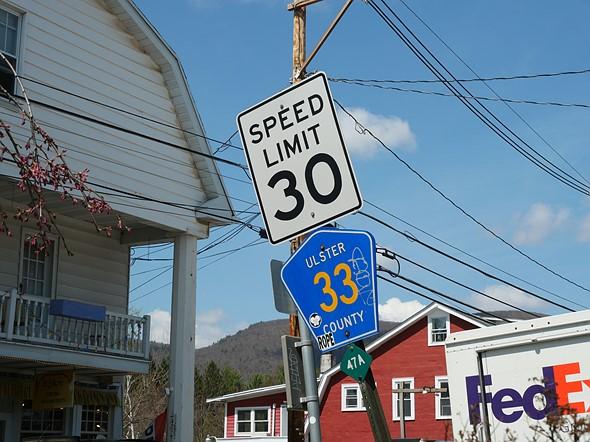
We primarily shot in Intelligent Auto mode while shooting stills with the G100 and were impressed by the quality of out-of-camera JPEGs. The images shot with the G100 have a nice amount of contrast and colors that popped; generally speaking these are stills that wouldn’t need a lot of post processing to get them ready to share on social platforms or dropped into a video.
The G100 is built around a 20MP Four Thirds CMOS sensor and although the image quality is great when shooting outside in sunny conditions and low ISOs, it starts to degrade at ISOs above 3200. The camera has a pop-up flash for shooting in low-light situations, but it’s pretty overpowering and will leave your subjects looking rather washed out.
When shooting in Intelligent Auto mode the G100 does a very good job of figuring out what you are trying to shoot, and adjusting its settings to match. The face detection makes it particularly good for shooting portraits, but during our time with the camera we found that it was also good at identifying and automatically switching into Landscape mode and Macro mode.

Since the G100 is primarily aimed at vloggers and content creators it’s important that it can produce good-looking stills even if the photographer lacks technical know-how, and on that level the G100 succeeds. The G100 does a good job of metering and the out-of-camera JPEGs are generally quite good. The camera gives users the ability to edit Raw files in-camera to adjust settings like white balance, contrast, highlights, shadows, saturation and shadows.
There are also some JPEG processing modes more akin to smartphone filters. A setting called 'Clear Retouch' allows users to remove distracting elements from the frame in-camera. In selfie-mode the G100 gives the option to apply skin smoothing, facial slimming and automatic background defocus while shooting, if you want to use these settings, make sure to apply them before you hit record - there isn’t an option to apply them after the fact.
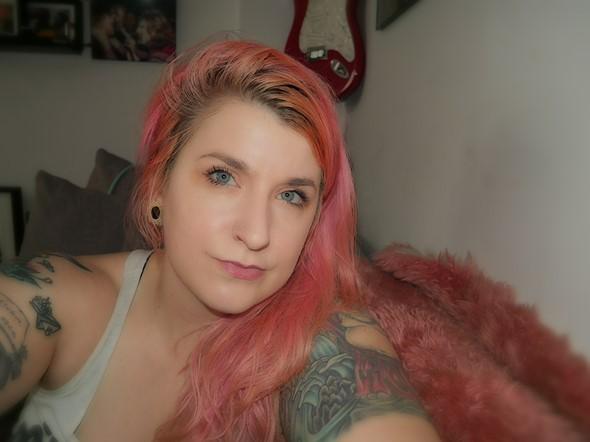
Return to index
When shooting stills the autofocus on the G100 is pretty impressive. It’s good at detecting faces and eyes and holding onto focus even if your subject is moving around. The video autofocus is a different story though. The autofocus in video mode does a lot of distracting focus hunting, knocking subjects in and out of focus with even the slightest movements. It’s better when the camera is in vlogging mode and the algorithm for tracking faces and eyes kicks in. If you are planning to use the camera for capturing 'walk-and-talk' footage and combine it with video sequences, that wandering autofocus will likely be a dealbreaker.
Return to index
Image stabilization and video autofocus work best on the G100 when the camera is flipped into vlogging mode and shooting at 1080p where it can utilize the digital 5-axis image stabilization: especially if you are shooting with the 12-32mm lens which includes optical image stabilization. When you start shooting in 4K mode the camera uses a cropped central region of the sensor to create the image, and those crops get even tighter when you switch into a 4K digital stabilization mode
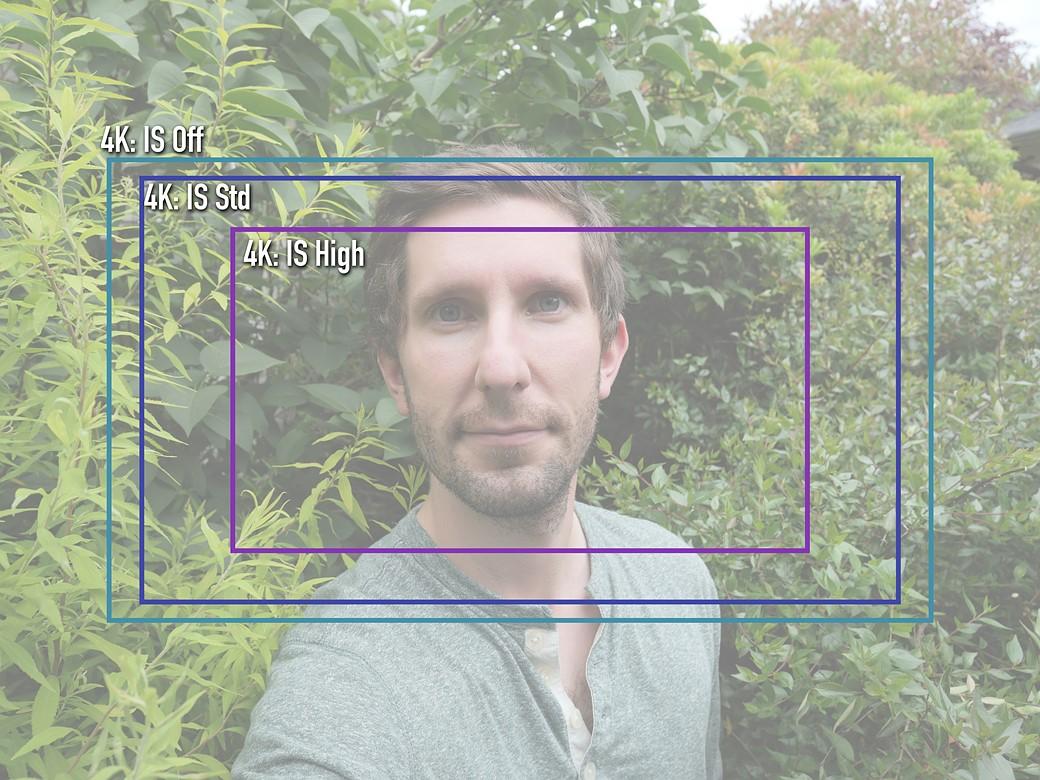
Crops in 4K mode
Crops in 1080 mode
Although 12mm sounds wide, when the camera is in vlogging mode and held at arm’s length with the selfie grip, the frame is quite tight. If you are a content creator doing a lot of walk-and-talk format videos you will typically want something with a wider field-of-view so that your viewers can see your face and whatever environment you happen to be in. This issue becomes even more pronounced if you aren’t a six-foot-tall person with long arms. We found the video crop to be a little too close when shooting 1080p, swapping into 4K IS mode makes the crop uncomfortably close.
I've been impressed by how well the audio tracking did when the G100 was in vlogging mode. It generally did a good job of following my voice when the camera was pointing at me, cutting down the sound of the river behind me. It’s not at great as cutting down on wind noise, but the G100 does feature a mic input which would likely help in windy situations. Unfortunately, as is the case with the majority of cameras aimed at vloggers, the camera lacks a headphone input so there is no way to monitor your audio quality as you are shooting.
When the camera isn’t in vlogging mode the autofocus tends to struggle, even with slow moving subjects. During our time with the camera I noticed a lot of focus hunting even when recording relatively simple scenes.
Recording time while shooting in 4K tops out at 10 minutes and 29:59 in 1080p mode. These time limits could be an issue for long-winded vloggers or anyone trying to use the camera to capture behind-the-scenes footage or record a performance.
Return to index
Compact body with a viewfinder makes it a great choice for photographers on-the-go
Ability to edit Raw images in camera
Directional audio tracking
If you assess the G100 as a camera designed for vloggers, you ultimately end up with a camera that is trying to do a lot of innovative things, but failing to do any of them particularly well. The audio tracking capabilities are pretty impressive, but they don’t mean much when you are dealing with a camera that struggles to hold autofocus and has such a tight crop in 4K mode that it’s useless for walk-and-talk style vlogging shots (without a really wide lens attached).
As a stills camera the G100 fairs slightly better. It has a nice viewfinder, a bright LCD screen, the ability to change lenses and an extremely compact body. The autofocus is good, as are the out-of-camera JPEGs and the ability to edit Raw images in camera makes this more appealing to someone who wants to quick share what they're shooting.
Although the audio-tracking is clever and works quite well, it’s just not enough to make this a camera we’d recommend for vlogging. If you're in the market for a vlogging camera, we think the Sony ZV-1 makes a lot more sense thanks to its autofocus capabilities and its directional 3-capsule microphone.
Return to index
Please do not reproduce any of these images without prior permission (see our copyright page). We make the originals available for private users to download to their own machines for personal examination or printing (in conjunction with this review).
Return to index
Scoring is relative only to the other cameras in the same category. Click here to learn about the changes to our scoring system and what these numbers mean.
Return to index
